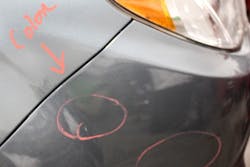A Process for Simplifying Your Collision Repair Mapping Process
The key to an efficient repair process is easy, says Jim Siegfried. It all boils down to effective communication that allows everyone in the shop to be on the same page.
As the owner of Crystal Lake Automotive in Lakeville, Minn., Siegfried is always on the lookout for new tools and processes that allow his staff to simplify the repair process. One of those tools is mapping, which involves using abbreviations and notations to circle damage and communicate the parts of the vehicle that do or do not need to be repaired.
Siegfried describes the mapping process in his shop, which he says has increased communication among technicians, reduced supplements and boosted customer service.
Right away, when the vehicle is brought in, we do a draft estimate with the customer. An estimator will go out with the customer to the car and go over the damage, just a three-minute visual in the front. We’ll walk around with the red paint marker and see anything that’s obviously damaged, circle the damage and write “prior damage.” From there, the car is brought back to the pre-wash area and the keys are hung on the board.
After a light wash, the production manager will look at the vehicle and mark prior damage, scratches or door dings. With the red marker, which is the paint marker used by production managers, we’ll circle the various damage and use index codes to quickly communicate the repairs required on the vehicle. An example would be “R” for replace, “X” for repair, “B” for blend.
It’s a universal code we have in the shop. We utilize three different colors for this process, too. Green means it’s OK to repair, red is prior or no repair, and yellow is questionable, meaning we haven’t heard back from the customer or the insurance company. The techs know not to do anything until that color changes. Then, when the question has been resolved, any circles that were previously in yellow or red are updated with the green marker.
The tech has his own set of markers and will mark additional things and write notes down on a side window. Once the vehicle is properly mapped, the repair planner will then record the repair grid on the rear window of the vehicle to ensure all information is available to anyone who works on the vehicle. At this point, a draft estimate has been written and that will turn into a repair order. Before writing that grid, the repair planner will go over all the mapping with the technician and ensure that everything is correct. By doing that, it helps eliminate supplements. Everyone has a little skin in the game—they looked the car over.
The other aspect is photographing the mapping that you’ve done. In today’s day and age, with not a lot of adjusters looking at cars, you need to be able to write your estimate from the pictures you’re taking. Anyone else should be able to look at your pictures and see, does this show four hours of damage? Does this show that it needs to be replaced?
Using the flash or not using the flash can make a world of difference. A flash will show a dent a little more. Taking a picture inside versus outside or vice versa. We also use zebra boards. They’re boards with horizontal lines that, when held up to the vehicle, show the dent right away, particularly if you take a picture with flash. Sometimes videos can be helpful, too. If you have a bent wheel, put it up in the air, spin the wheel and do a little video clip.
